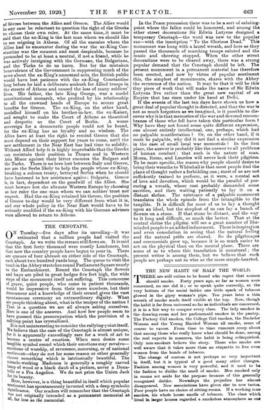THE CENOTAPH.
ON Tuesday—five days after its unveiling—it was estimated that a million people had visited the Cenotaph. As we write the stream still flows on. It is said that the -first forty thousand were mostly Londoners, but that now the country people have begun to pour in. There are queues of four abreast on either side of the Cenotaph, each about two hundred yards long. The queue to visit the tomb in the Abbeystretches round Parliament Square nearly to the Embankment. Round the Cenotaph the flowers' and bays are piled in great hedges five feet high, the wide steps of the monument itself not sufficing. This concourse of grave, quiet people, who come in patient thousands, would be impressive from their mere numbers, but their demeanour and a knowledge of their errand niveo the vast Spontaneous ceremony an extraordinary dignity. What are people thinking about, what is the teniper of the nation That is a question we are all always asking ourselves. Here is one of the answers. And how few people seem to- have guessed this preoccupation which the provision of a rallying-point has crystallized. It is not uninteresting to consider the rallying-point itself. We believe that the case of the Cenotaph is almost unique, for it is apparently exceedingly rare for a work of art to become a centre of emotion. When men desire some tangible symbol round which their emotions may revolve— emotions of warship, of reverence, mourning, or of national sentiment—they do not for some reason or other generally choose something which is intrinsically beautiful. The rairacle-working Madonna is generally a roughly carved lump of wood or a black daub of a picture, never a Dona- tello or a Fra Angelico. We do not prize the Union Jack for its beauty. Here, however, is a thing beautiful in itself which popular Sen_. .timent has spontaneously invested with a deep symbolic ilginficance. Our readers will remember that the Cenotaph was not originally intended as a permanent memorial at all, far leas as the memorial In the Peace procession there was to be a sort of saluting. point where the fallen could be honoured, and among the other 'street decorations Sir Edwin Lutyens designed temporary Cenotaph—the word was new to the popular • ear—with the inscription "To the Glorious Dead." This monument was hung with a laurel wreath, and- here as they passed the thousands of marching troops saluted and the music and cheering stopped. When the other street • decorations were to be cleared away, there was a strong popular demand that the Cenotaph should be left. The present monument in a permanent material has therefore been erected, and now by virtue of popular sentiment this, the simplest of monuments, shares with the Abbey the reverence of the nation. It may be that it will be this tiny piece of work that will make the name of Sir Edwin Lutyens live rather than the great new capital of an Empire that has risen under his hand at Delhi.
If the events of the last ten days have shown us how a great deal of popular thought is directed, and that the war is not as much forgotten as we imagined, is it possible to dis- cover why it is that memories of the war and devoted remem- brance of those who fell have taken this particular form? Why have they not found some quite different expression, one almost entirely intellectual, one, perhaps, which had • no palpable manifestation I Or, on the other hand, if it must be palpable, why did it not find a similar expression in the case of small local war memorials ? In the first place, the answer is probably like the answer to all problems of human conduct : that such is the nature of man. 'Mecca, Rome, and Lourdes will never leak their pilgrims. To be more specific, the reason why people should desire to bring their wreaths to Whitehall-is that most people find the plane of thought rather a forbidding one ; most of us are not sufficiently trained to perform, as it were, a mental act of love and devotion, which would be the parallel of pro- curing a wreath, whose cost probably demanded some sacrifice, and then waiting patiently to lay it on a distant shrine. The existence of a palpable monument translates the whole episode from the intangible to the tangible. It is difficult for most of us to lay a thought upon an ideal, but the simplest of us can lay a bunch of flowers on a stone. If that stone be distant, and the way to it long and difficult, so much the better. That at the central shrine the pilgrim will see a great number of like- minded people is an added inducement. There is inspiration and even consolation in seeing that the natural feeling and the natural pride are shared. So do pilgrimages- and ceremonials grow up, because it is so much easier to act on the physical than on the mental plane. There are some of us to whom this translation is unnatural ; the present writer is among them, but we believe that such people are perhaps not so wise as the more simple-hearted.


































 Previous page
Previous page